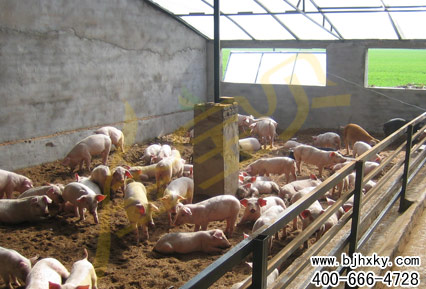Because of the advantages of environment-friendly deodorization, resource conservation, lower operating costs, and the ability to produce organic green pork, the swine-type fermentation bed pigs are being used by a large number of farmers, and their application value and prospects are broad. However, in the process of planning, construction and operation of the dry spreader bed, improper operation may cause the fermentation bed to be unable to operate effectively, and severely cause bad beds and dead beds. The majority of farmers need to pay special attention to the following points.

Second, the fermentation bed pig fence set pig bed pig farm fence railing or barbed wire, try not to use solid walls. Each pigsty 20-60 square meters, the best square, small piglets can be larger. Pregnant sow 25 square meters raise 8 pigs, nursing sows single circle 6-8 square meters.
Third, the fermentation bed pig drinker and trough set fermentation bed set up one or two drain stations for each circle, built under the drinking fountain drainage platform. It is best to use a nipple or bowl drinker. 3-6 months overhaul or replace the water dispenser pad and spring. Hog drinking fountains and chutes are located on opposite sides and a whole body cement chute can be built next to the sidewalks.
Fourth, the fermentation bed pig litter preparation Fermentation bed pig bedding selection criteria are: higher carbon and nitrogen ratio, better breathable water retention performance. Sawdust, wood shavings, rice husks, peanut shells, corn cobs, etc. are all available. Sawdust is preferred. A ton of sawdust can be spread over 10 m2. Sawdust can be used alone or mixed with others. The litter requires drying, no mildew, and no obvious impurities. The litter needs to be cool before being laid, which can effectively remove harmful pest eggs.
5. Dilution strains in the production of the fermentation bed Fermentation bed strains in the production of the fermentation bed (please click here for details) need to be diluted with corn flour or bran or rice hull. The purpose of dilution will be more conducive to the uniform mixing of bacteria species and litter, and provide nutrients and sites for the expansion of bacteria species. The dilution ratio is 1 to 5 or 1 to 10, requiring uniform mixing.
Sixth, the padding in the production of fermentation beds The padding in the production of the fermentation bed is divided into five layers. 10-15 cm per floor. Each layer of padding evenly spread a strain of bacteria. The lower quality dunnage lays the lower layer and the good dunnage spreads the upper layer. A small amount of wet litter is laid on top. Padding thickness of about 60 cm, after entering the pig practical about 50 cm. When the litter is covered, it can be fed to the pigs.
7. Routine maintenance of the fermentation bed periodically bury the excrement in the litter, depending on the specific conditions. Exfoliate urine and dunnage. The compacted dunnage turned loose in time. Large pigs occupying no more than 1.2-1.5 square meters of padding material per head shall not exceed the standard. Pay attention to ventilation in order to facilitate the timely discharge of water vapor inside the house; also pay attention to warm winter and summer cooling. In short, the normal and effective operation of the fermentation bed requires the farmer to be serious and responsible.
Eight, the fermentation bed pig litter to supplement the fermentation bed pig litter significantly less than 50 cm thick should be promptly added new litter. After one year of operation, the entire fermentation bed will become thinner, and new litter and fungicide must be added. In addition, when pigs are slaughtered, they can also be supplemented with litter.
Nine, fermentation bed pig housing disinfection
The fermentation bed housing can be fully sterilized, but the focus is on the aisles, gates, and access to vehicles. General disinfection has no obvious effect on fermentation function.
X. Fermentation of bed-raising pig diseases focuses on creating a good living environment, and improving pig constitution is the fundamental prerequisite for controlling the disease. Vaccination against swine fever and foot-and-mouth disease vaccines simplifies other vaccination procedures. The quality of good feed, especially moldy corn. Use medicine scientifically and do not abuse drugs. Details can be consulted: Beijing Huaxia Kangyuan Technology Co., Ltd. Telephone Toll Free Hotline Recommended Reading1. The father of China's dry ecological fermentation bed
2. What is good for the use of pig bed mats in fermentation beds?
3. Several major factors affecting the operation of the fermentation bed.
Toilet Cleaner,Toilet Bowl Cleaner,Toilet Cleaning,Toilet Cleaning Powder
Wuxi Keni Daily Cosmetics Co.,Ltd , https://www.kenicosmetics.com